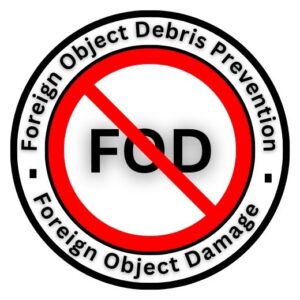 Damage caused by foreign object debris (FOD) at airports costs airlines, airports, and tenants at airports millions of dollars annually.
Damage caused by foreign object debris (FOD) at airports costs airlines, airports, and tenants at airports millions of dollars annually.
Foreign Object Debris Prevention refers to any item that has been stowed away in an unsafe place that may cause harm to an airplane or airport workers if it were to be used. The annual cost to the aircraft sector of the associated damage is projected to be over $4 billion. Airports, airlines, and tenants may all benefit from preventing airport FOD, which will save costs and mitigate any threats to flight safety.
Training
Everyone who works at or uses an airport, including airline employees and tenants, should be educated on the dangers of FOD and how to eliminate them. This instruction may enhance the overall Foreign Object Debris Prevention awareness integrated into the airside driver-training curriculum at many airports. FOD training for flight crews comprises following the recommended procedures listed in the Flight Crew Operating Manual and pre- and post-flight inspection procedures covered during line training.
Effective training should emphasize the risks to staff and passengers, the dangers to equipment, the direct costs involved with FOD damage, and the indirect expenses connected with flight delays and rescheduling. It should also contain methods for removing and eradicating FOD at its source and should be reinforced via posters and signage. Maintaining knowledge of FOD requires further training sessions.
The International Civil Aviation Organization (ICAO) demands a daily daylight examination of aircraft maneuvering zones and clearance of FOD. The airside crew should do these checks at the start of each day or shift and as part of their regular duties.
It’s important to check on construction sites more often while work continues. It may even require specialized employees to examine for FOD during significant construction operations regularly. Flight crews must notify air traffic control and station operations of any FOD found on airport property. Before moving an aircraft into or off of a parking stand, its operator or handling agency should appoint someone to check the stand.
Responsibility of Foreign Object Debris Prevention
All airport users share some degree of responsibility for FOD prevention and clearance; nevertheless, particular duties must be delegated to competent personnel who are appropriately educated and supervised. Quality assurance is crucial for organizations and individuals to fulfill their duties effectively.
Airline representatives or handling agents are typically responsible for keeping the gate and approaches clear of foreign object debris (FOD), including ground equipment, and free of ice, snow, or another contaminant capable of affecting braking action. The airport authority oversees the runways, taxiways, and general maneuvering areas. Agents’ processes and the terms of their handling contracts should indicate how such tasks will be carried out.
Conclusion
FOD created by airport construction should be managed and contained as part of the airport’s pre construction planning. The risk of debris becoming airborne increases in areas with heavy winds. Highways leading to and from building sites must steer clear of flight paths. Contractors are responsible for ensuring that they are familiar with the terms of their contracts, including any provisions related to the prevention, detection, and removal of FOD.
